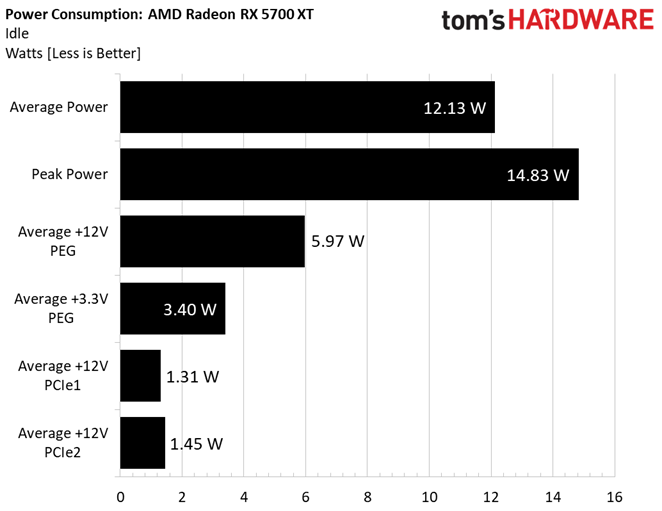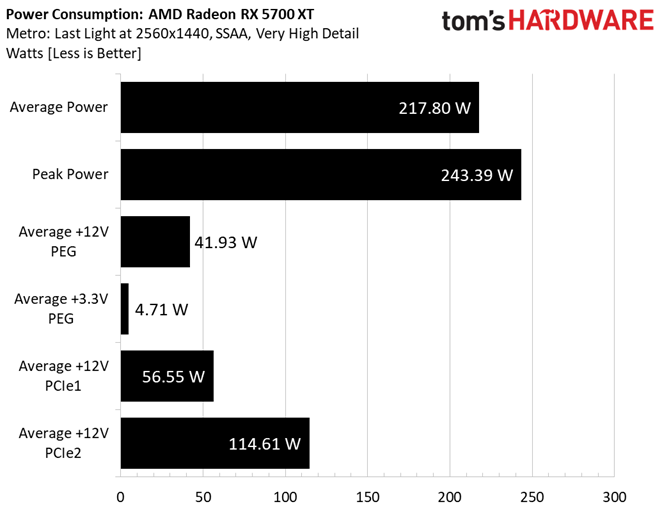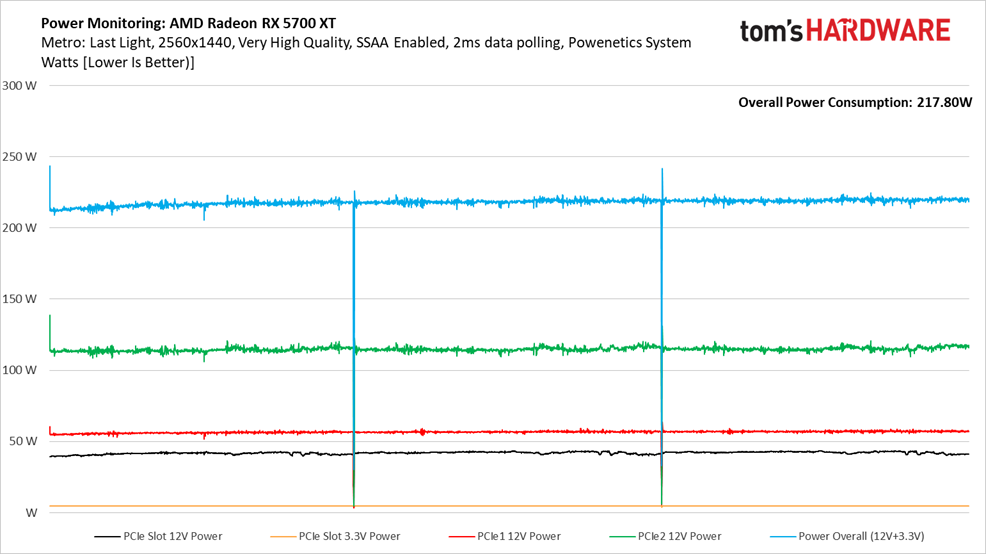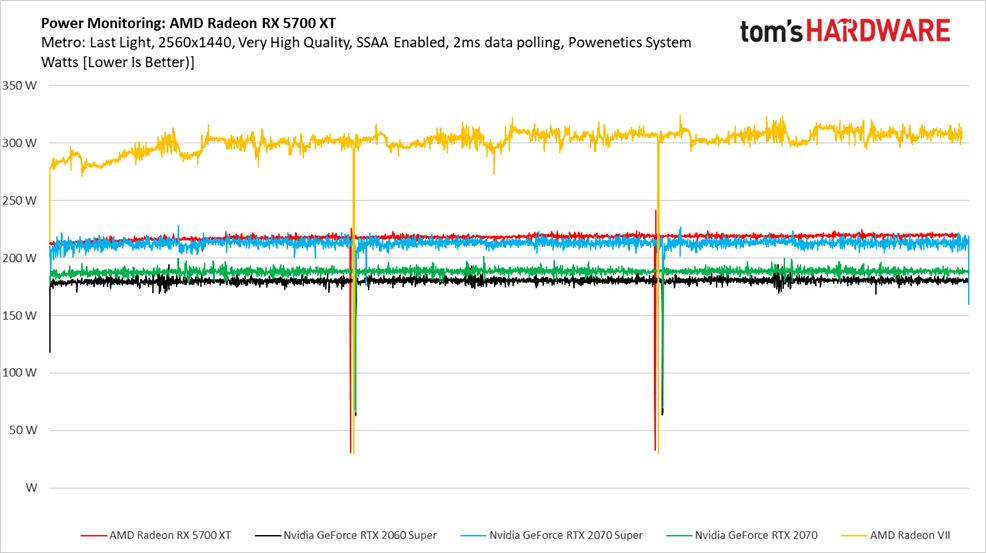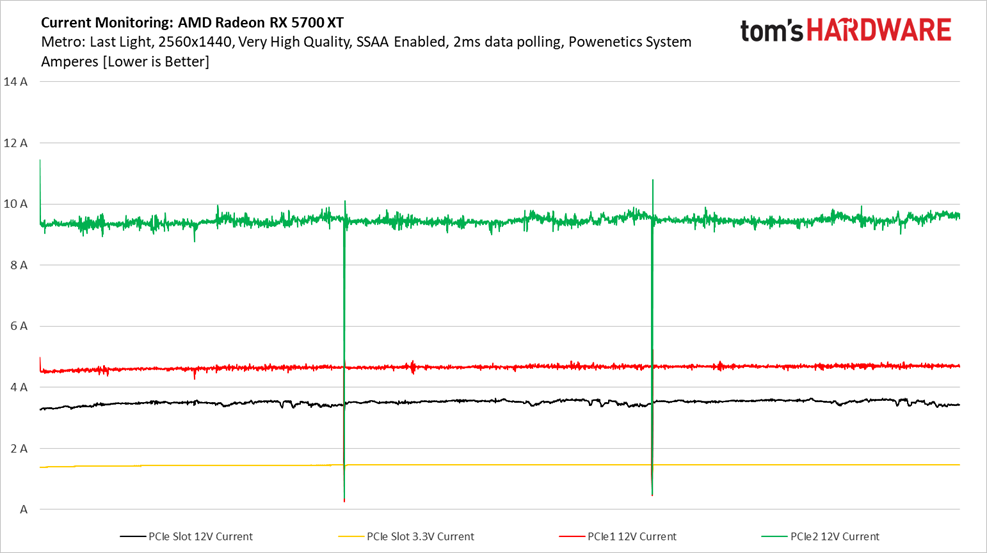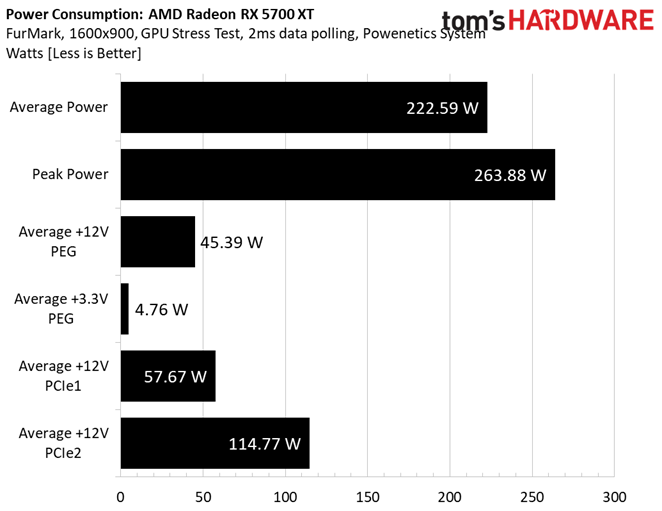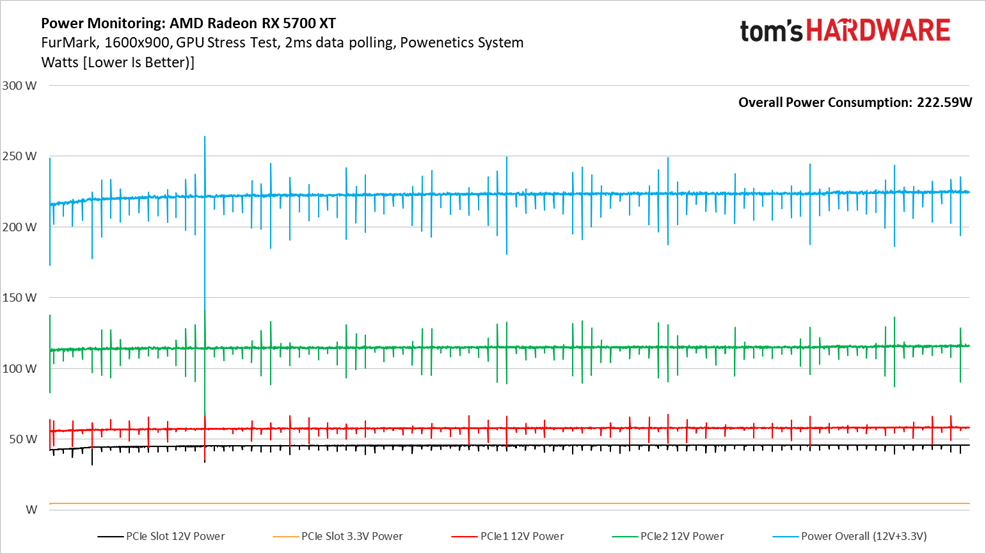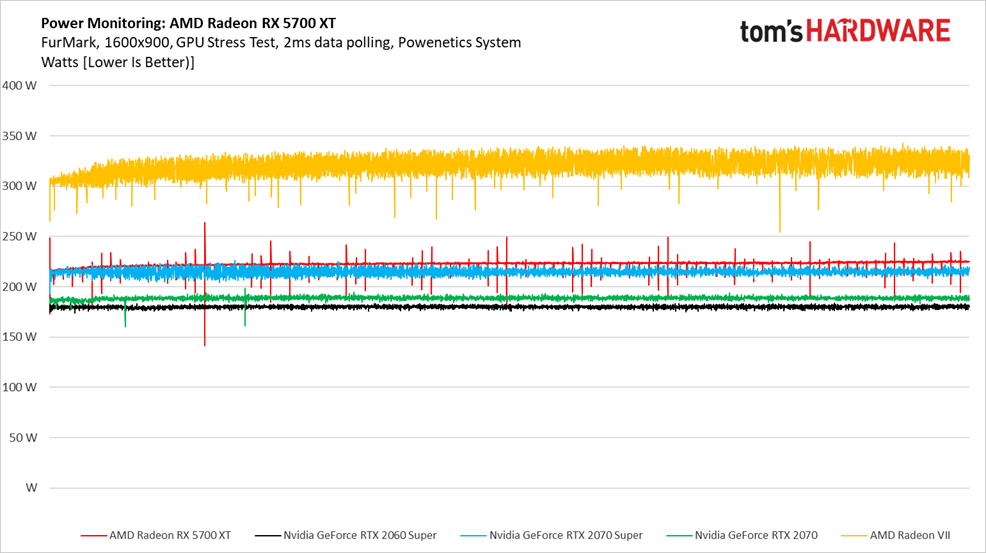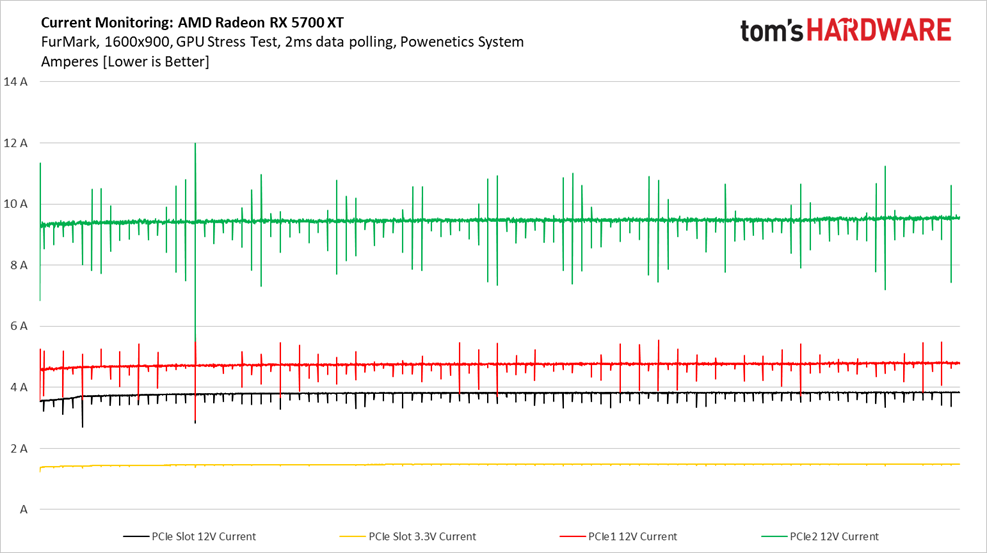AMD Radeon RX 5700 XT and Radeon RX 5700 Review: New Prices Keep Navi In The Game
The Radeon RX 5700 series bests its Nvidia competitors but lacks ray tracing and tensor core hardware.
Why you can trust Tom's Hardware
Idle
The Radeon RX 5700 XT dissipates slightly more power than the vanilla 5700 at idle, though it’s a minor 2 percent difference.
Gaming
Like its Radeon RX 5700, AMD’s higher-end 5700 XT averages less power consumption through our three-loop benchmark sequence than the company’s 225W board power specification. A single 243W peak is nothing to worry about.
The two dips in our chart correspond to breaks between loops in our Metro benchmark sequence. Otherwise, power consumption over time is relatively steady.
Radeon RX 5700 XT averages ~5W-higher power consumption compared to Nvidia’s GeForce RTX 2070 Super in this workload. Again, AMD made serious headway in improving performance per watt, contrasted by the Radeon VII’s >300W average.
FurMark
Average power through 15 minutes of FurMark rises slightly versus what we saw under Metro. The Radeon RX 5700 XT keeps its trend line under 225W, though.
A peak measurement of almost 264W is a one-time event caused by a spike to 11.98A following a dip to 5.53A.
Notice that every power consumption spike is preceded by a dip, but not every dip is compensated for with a spike. Both Navi-based Radeons, then, demonstrate similar behavior under extreme workloads like FurMark. Check out the previous page for AMD’s explanation. In short, both Radeon RX 5700-series cards are protecting themselves from this taxing application.
Get Tom's Hardware's best news and in-depth reviews, straight to your inbox.
Noisy readings aside, the Radeon RX 5700 XT does use more power than GeForce RTX 2070 Super, but significantly less than Radeon VII.
These are the current measurements that multiply into each rail’s voltage to yield power. The eight-pin connector is by far the most affected by FurMark’s demands, through the six-pin and motherboard slot demonstrate similar behavior.
MORE: Best Graphics Cards
MORE: GPU Benchmarks
MORE: All Graphics Content
Current page: Power Consumption: Radeon RX 5700 XT
Prev Page Power Consumption: Radeon RX 5700 Next Page Fan Speeds, Clock Rates, and Temperatures-
ICWiener Honestly I'd pay the extra just for Nvidia's decent cooler, let alone power consumption, RTX, etc. Hard pass on another blower.Reply -
justin.m.beauvais Dear AMD,Reply
Why? Wasn't your line GTX 1080 performance at RX 580 prices? points at Navi This is not that.
Regrettably yours,
Your Fans -
alextheblue Reply
I read the review, don't know what you mean by "let alone power consumption". Efficiency is virtually the same. I personally prefer blowers as long as they're not crazy loud, and the review says they're not so I'm all for it. If you DON'T like blowers, I'm sure there will be third-party coolers that improve cooling performance and acoustics further (and dump heat into the chassis like crazy).ICWiener said:Honestly I'd pay the extra just for Nvidia's decent cooler, let alone power consumption, RTX, etc. Hard pass on another blower.
Who ever promised that? They are 10-11% faster than same-priced Nvidia models. They're not going to drop 5700 $100 bucks when they're already ahead by 11%, even though I would love lower prices, there's no incentive for them to do so.justin.m.beauvais said:Dear AMD,
Why? Wasn't your line GTX 1080 performance at RX 580 prices? points at Navi This is not that.
Regrettably yours,
Your Fans -
face-plants I'm pleasantly surprised by both the performance AND the last-minute drop in price. Personally I don't like blower style cards and will be on the lookout for third-party offerings with more traditional dual fan coolers. This is totally personal preference as I tend to build in bigger cases with plenty of ventilation to deal with the extra heat. If the prices don't get too out of line from the AIBs then I'll gladly give a few of these cards a go in upcoming builds. I'm also expecting a decent improvement in thermals so hopefully these FE cards aren't exemplary of the best cooling you can get on air. The prospect of building all AMD machines in the coming months has got me totally nerding out.Reply -
kinggremlin Replyalextheblue said:I read the review, don't know what you mean by "let alone power consumption". Efficiency is virtually the same. I personally prefer blowers as long as they're not crazy loud, and the review says they're not so I'm all for it. If you DON'T like blowers, I'm sure there will be third-party coolers that improve cooling performance and acoustics further (and dump heat into the chassis like crazy).
Who ever promised that? They are 10-11% faster than same-priced Nvidia models. They're not going to drop 5700 $100 bucks when they're already ahead by 11%, even though I would love lower prices, there's no incentive for them to do so.
You didn't read the review. Ignoring the Furmark results which don't mirror any realworld scenario. The 5700xt is slower than the 2070 Super while using more power and running over 10degrees C hotter in gaming. -
alextheblue Reply
Yes, I did, stop being obstinate. Ah, I get it, you must have read "efficiency" in my post as "power consumption", or something. Why are you comparing it to the 2070 Super? The 5700 is the same price as the 2060 and 11-12% faster on average (between TH and AT), and the 5700XT is the same price as the 2060 Super and roughly 10-11% (TH-AT) faster. Yes, they use more power, but they're faster. As a result the efficiency is pretty close. It varies based on workload (game title), but I have read the reviews here and AT (so far, haven't looked at a third review yet). Here:kinggremlin said:You didn't read the review. Ignoring the Furmark results which don't mirror any realworld scenario. The 5700xt is slower than the 2070 Super while using more power and running over 10degrees C hotter in gaming.
https://www.anandtech.com/show/14618/the-amd-radeon-rx-5700-xt-rx-5700-review/15
Factor in the performance gain (in AT's suite it was 11% for the XT and 12 for vanilla 5700) and you'll see their power consumption is pretty good. Average that with TH's results in Metro: LL and the final efficiency is pretty neck and neck with their direct competitors.
I didn't say they didn't run hot. For people that don't like blowers (as I already said) there will be cooler, quieter third party options. -
digitalgriffin Replyalextheblue said:I read the review, don't know what you mean by "let alone power consumption". Efficiency is virtually the same. I personally prefer blowers as long as they're not crazy loud, and the review says they're not so I'm all for it. If you DON'T like blowers, I'm sure there will be third-party coolers that improve cooling performance and acoustics further (and dump heat into the chassis like crazy).
Who ever promised that? They are 10-11% faster than same-priced Nvidia models. They're not going to drop 5700 $100 bucks when they're already ahead by 11%, even though I would love lower prices, there's no incentive for them to do so.
In all honesty, all these cards are expensive. $350 would have been the most I wanted to pay for a 5700XT. And the card does run hot. Pascal was a small move up in prices. Turing was just insane pricing wise.
That being said I bought one today and said "F"-it. I just don't like NVIDIA's business ethics. It will get the job done for two to three years. -
randomizer How many engineers looked at those fan curves in lab testing and thought they were good?Reply
I think this release is a bit underwhelming. Local pricing here makes the RX 5700 fairly unattractive compared to a 2060, but the XT is better positioned against the 2070. Not sure it's really worthwhile upgrading a 970 though. -
daglesj So for the many of us on a RX480?...Reply
Worth it? Could someone not dig out the previous AMD midrange value demon to test against? C'mon...
